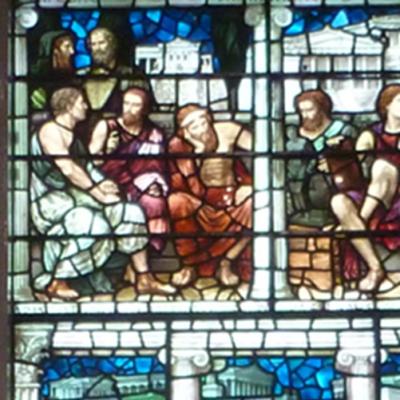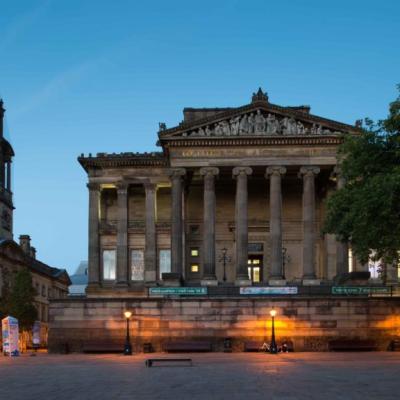Stained Aristotle

Peer up at the top left-hand panel of the stained-glass window celebrating ancient Greek achievements in the Harris Museum in Preston. Aristotle is second from left, standing, and talking to other philosophers. Commissioned in 1905, the window’s creator was Henry Holiday, a colourful character who campaigned for Irish independence, women’s suffrage, socialism and dress reform. He believed that homo sapiens was being destroyed by sartorial uniformity and that we should all wear different clothes. He personally liked to wear an outfit of medieval chain-mail. But he was obsessed with Greek art, designing a frieze ‘Apollo and the Muses’ for Clifton Theatre, and for years keeping a cast of Praxiteles’ Hermes and an enormous model of the Acropolis he had constructed for himself in his studio.
The lowest window panel portrays Sappho, Aeschylus, Sophocles, Euripides and Homer, with quotations in ancient Greek from Sappho and the Iliad. The middle panel, with its Greek inscription ‘The Great Panathenaea’, is a vivid rendition of some Parthenon horsemen. The mill-workers of Preston, in the mid-19th century far-famed for their mutinous strike actions, could learn a great deal about ancient Greece in a single afternoon at their museum.
The Preston Corporation set up the museum to honour the memory of the Reverend Robert Harris (1764-1762). The longstanding Headmaster of Preston Grammar School, he was himself the upwardly mobile son of a ‘goods carrier’ whose success was owed to his talent for Classics, spotted in childhood. The grand neoclassical building features an imposing pediment in the tympanum. Pericles sits helmeted in the centre of twelve other figures representing philosophers, poets, orators and artists. Around the lantern the epigraph reproduces a sentence from Pericles’ ‘Funeral Speech’ in Thucydides. The sides of the building bear two inscriptions from Marcus Aurelius’ Meditations.


